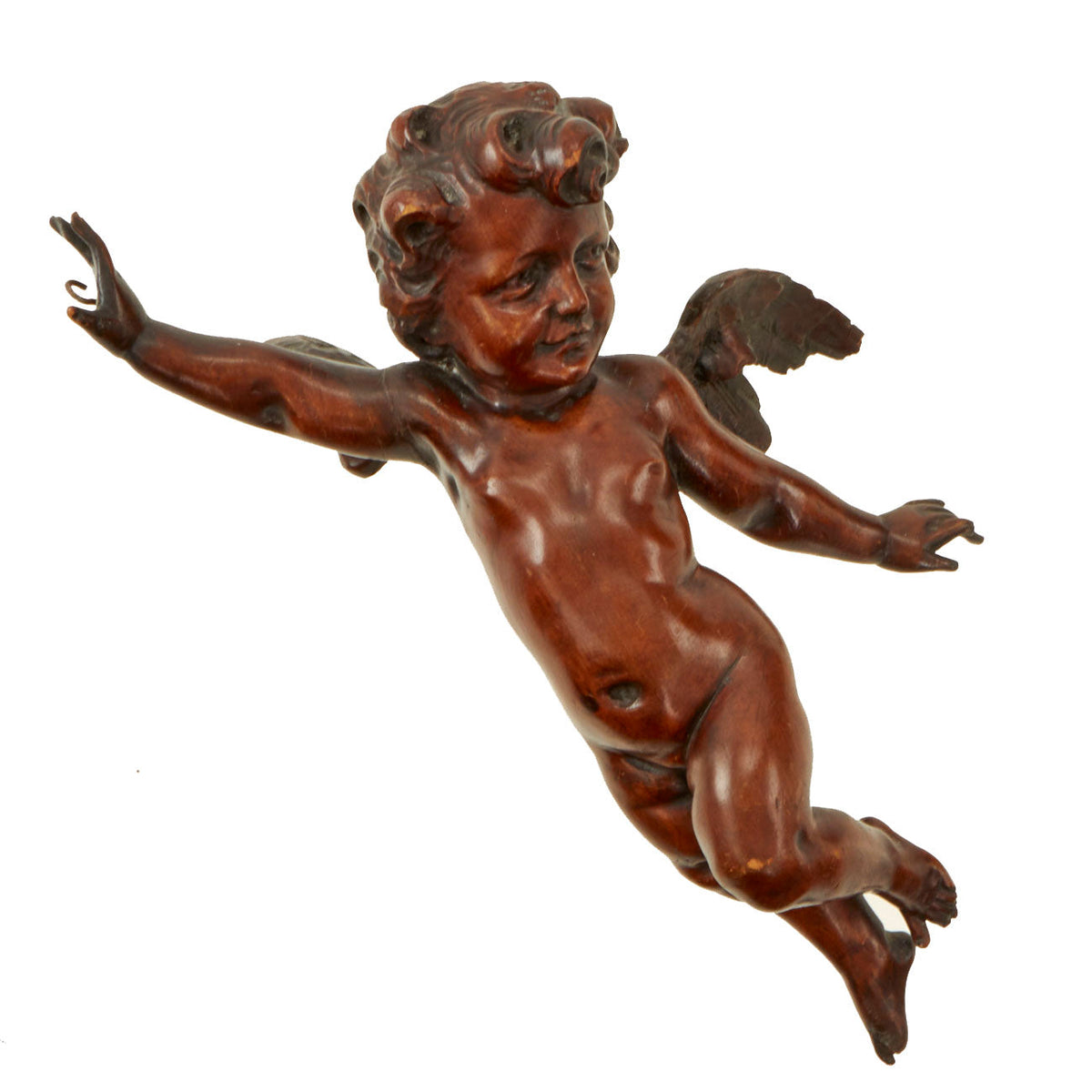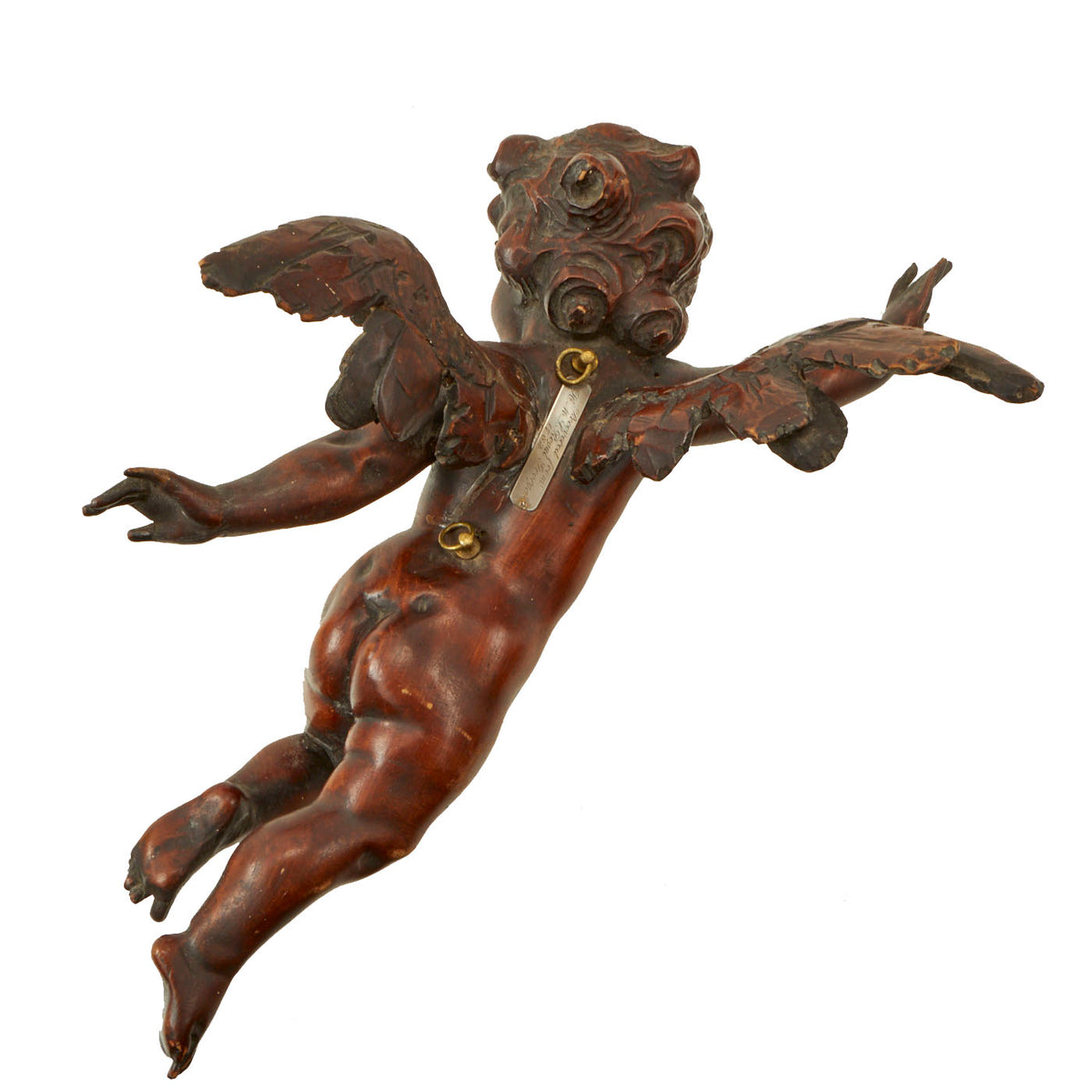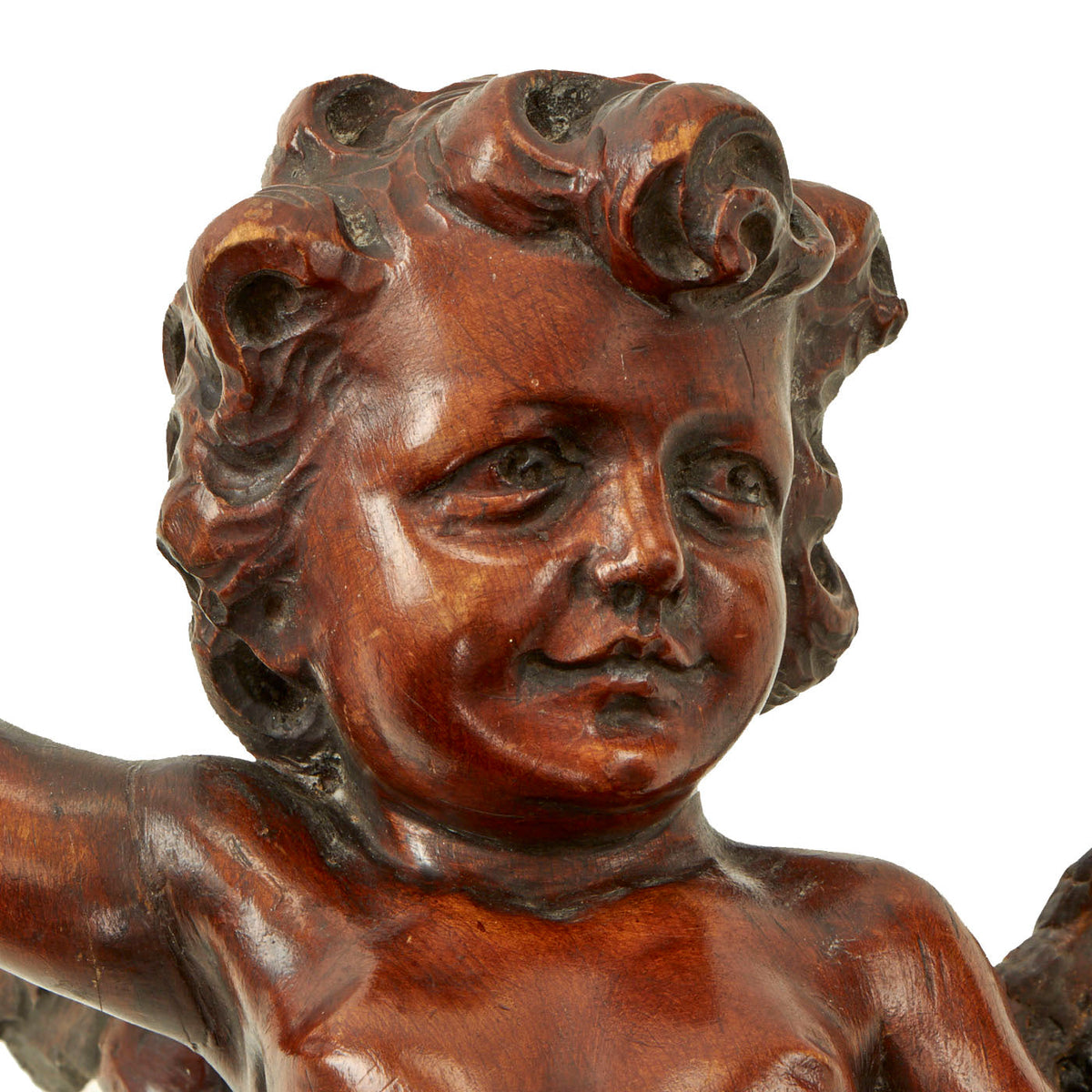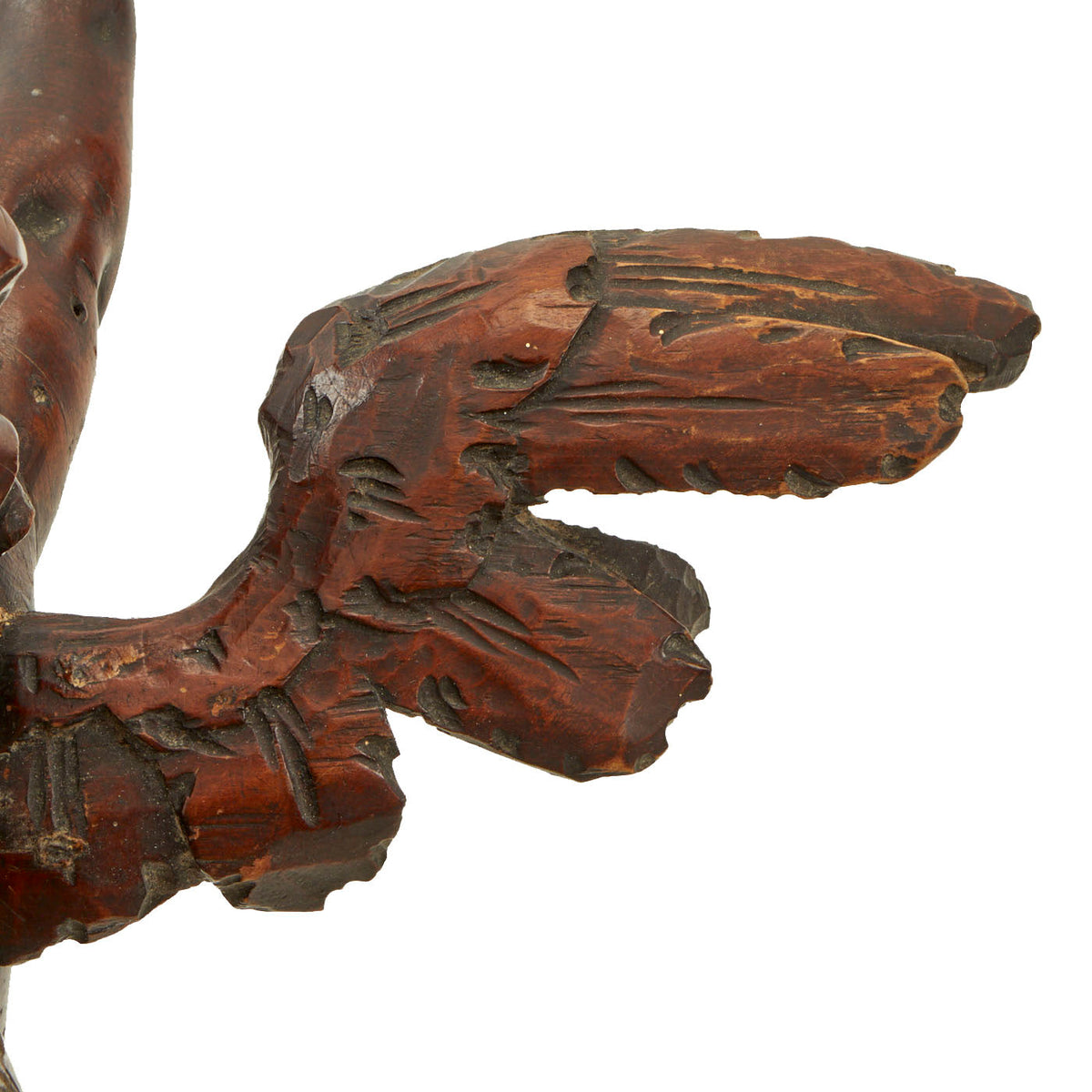Original British 18th Century Winged Angel Cherub Recovered from the H.M.S. Royal George Wreck in 1782 By Charles Spalding Original Items
$ 1.495,00 $ 373,75
Original Item: One Of A Kind. This is an absolutely incredible piece of art and history. This hand-carved wooden Cherub dates back to roughly the 18th century, possibly earlier. This was more than likely in the Captain’s Cabin of the H.M.S. Royal George at the time of her foundering on August 29, 1782. In the following months, Charles Spalding, while using a diving bell of his own design, recovered many items from the Royal George.
There is a 2” long silver tag tacked onto the back of the Cherub with the following information inscribed on it:
Recovered From
H.M.S. Royal George
1782
The condition is very nice, especially given the age and what the ship went through while in service. There are a few nicks and scratches throughout the wood, as well as chipping but that’s expected. There are brass mounting hardware present on the back and right hand, it is unclear if this was done period or much later for display purposes. It measures about 14 1/2 inches long, with a wingspan of 9 3/4 inches.
This is an incredible, once in a lifetime opportunity to add this to your early British maritime collections! Comes more than ready to display.
HMS Royal George
HMS Royal George was a ship of the line of the Royal Navy. A first-rate with 100 guns on three decks, she was the largest warship in the world at the time of her launch on February 18, 1756. Construction at Woolwich Dockyard had taken ten years.The ship saw immediate service during the Seven Years’ War, including the Raid on Rochefort in 1757. She was Admiral Sir Edward Hawke’s flagship at the Battle of Quiberon Bay in 1759. The ship was laid up following the conclusion of the war in 1763, but was reactivated in 1777 for the American Revolutionary War. She then served as Rear Admiral Robert Digby’s flagship at the Battle of Cape St Vincent in 1780.
Royal George sank on 29 August 1782 while anchored at Spithead off Portsmouth. The ship was intentionally rolled so maintenance could be performed on the hull, but the roll became unstable and out of control; the ship took on water and sank. More than 800 lives were lost, making it one of the most deadly maritime disasters in British territorial waters.
Several attempts were made to raise the vessel, both for salvage and because she was a major hazard to navigation in the Solent. In 1782, Charles Spalding recovered fifteen 12-pounder guns using a diving bell of his own design. From 1834 to 1836, Charles and John Deane recovered more guns using a diving helmet they had invented. In 1839 Charles Pasley of the Royal Engineers commenced operations to break up the wreck using barrels of gunpowder. Pasley’s team recovered more guns and other items between 1839 and 1842. In 1840, they destroyed the remaining structure of the wreck in an explosion which shattered windows several miles away in Portsmouth and Gosport.
Service History
Due to problems encountered during the War of the Austrian Succession (1740–48), the Admiralty attempted to modernize British ship designs with the 1745 Establishment. On 29 August 1746, the Admiralty ordered construction of a 100-gun first rate of the new design, to be named Royal Anne. She was laid down at Woolwich Dockyard in 1746 but was unfinished when the war ended in 1748, causing construction to slow. The ship was renamed Royal George while under construction.
She was not completed until 1756, during the Diplomatic Revolution, a few months before the outbreak of the Seven Years’ War (1756–63). The ship was commissioned in October 1755, before she was ready to launch, with her first commander being Captain Richard Dorrill. She was launched on 18 February 1756. The largest warship in the world at the time, she displaced more than 2,000 tons and was the “eighteenth-century equivalent of a weapon of mass destruction”.
Royal George joined the Western Squadron (also known as the Channel Fleet) under Admiral Sir Edward Hawke in May 1756, just as the Seven Years’ War began. Captain Dorrill was succeeded by Captain John Campbell in July 1756, who was in turn succeeded by Captain Matthew Buckle in early 1757. Royal George was used as the flagship of Vice-Admiral Edward Boscawen in this period, including flying his flag during the Raid on Rochefort in September 1757. Captain Piercy Brett took command in 1758, and Royal George became the flagship of Admiral Lord George Anson in the same year. Brett was succeeded by Captain Alexander Hood in November 1758. The former captain, Richard Dorrill, returned to command the ship the following year, until being invalided in June 1759. Dorrill’s replacement was another former captain, John Campbell, who commanded her during the blockade of the French fleet at Brest. She became Sir Edward Hawke’s flagship in early November 1759, when his previous flagship, Ramillies, went into dock for repairs. Hawke commanded the fleet from Royal George at the Battle of Quiberon Bay on 20 November 1759, where she sank the French ship Superbe.
Royal George was commanded by Captain William Bennett from March 1760, and she was present at the fleet review at Spithead in July that year. John Campbell returned to command his old ship in August 1760, though Bennett was captain again by December. Royal George joined Admiral Charles Hardy’s fleet in the Autumn of 1762. With peace approaching, and the enormous cost of crewing and provisioning such a large ship, the crew were paid off on 18 December 1762. The ship was laid up in the ordinary at the conclusion of the war, along with most other first rates in the fleet. Whilst laid up, Royal George underwent a major repair at Plymouth between 1765 and 1768.
The ship was reactivated after the outbreak of the American War of Independence (1775–83), being re-fitted for service at Portsmouth between May 1778 and April 1779. She re-commissioned under Captain Thomas Hallum in July 1778, with command passing to Captain John Colpoys in November that year. Royal George was again assigned to the Channel Fleet, where she was flagship of Vice-Admiral Sir Robert Harland. Vice-Admiral George Darby briefly replaced Harland in June 1779, then from August 1779 to December 1781 she was the flagship of Rear-Admiral Sir John Lockhart Ross. Meanwhile, Captain Colpoys was replaced by Captain John Bourmaster in December 1779, and she joined Admiral Sir George Rodney’s fleet in their mission to relieve Gibraltar. Under Bourmaster, and flying Ross’s flag, Royal George took part in the attack on the Caracas convoy on 8 January 1780, the Battle of Cape St. Vincent on 16 January, and took part in the successful relief of Gibraltar three days later.
Royal George returned to Britain with the rest of the fleet, and had her hull coppered in April 1780. She returned to service that summer, serving with the Channel Fleet under Admiral Francis Geary, and then George Darby again from the autumn. Both captain and admiral changed again in late 1781, Bourmaster being replaced by Captain Henry Cromwell, and Ross by Rear-Admiral Richard Kempenfelt. She served as part of Samuel Barrington’s squadron from April 1782, with Cromwell replaced by Captain Martin Waghorn in May. Royal George then joined the fleet under Richard Howe.
Fate
On 28 August 1782 Royal George was preparing to sail with Admiral Howe’s fleet on another relief of Gibraltar. The ships were anchored at Spithead to take on supplies. Most of her complement were aboard ship, as were a large number of workmen to speed the repairs. There were also an estimated 200–300 relatives visiting the officers and men, 100–200 “ladies from the Point [at Portsmouth], who, though seeking neither husbands or fathers, yet visit our newly arrived ships of war”, and a number of merchants and traders come to sell their wares to the seamen. The reason most of her complement were aboard was because of fear of desertion: all shore leave had been canceled. Accordingly, every crew member then assigned to the vessel was aboard it when it sank, except for a detachment of sixty Marines sent ashore that morning. The exact number of the total crew on board is unknown, but is estimated to be around 1,200.
At seven o’clock on the morning of 29 August work on the hull was carried out and Royal George was heeled over by rolling the ship’s starboard guns into the centreline of the ship. This caused the ship to tilt over in the water to port. Further, the loading of a large number of casks of rum on the now-low port side created additional and, it turned out, unstable weight. The ship was heeled over too far, passing her center of gravity. Realizing that the ship was settling in the water, the ship’s carpenter informed the lieutenant of the watch, Monin Hollingbery, and asked him to beat the drum to signal to the men to right the ship. The officer refused. As the situation worsened, the carpenter implored the officer a second time. A second time he was refused. The carpenter then took his concern directly to the ship’s captain, who agreed with him and gave the order to move the guns back into position. By this time, however, the ship had already taken on too much water through its port-side gun ports, and the drum was never sounded. The ship tilted heavily to port, causing a sudden inrush of water and a burst of air out the starboard side. The barge along the port side which had been unloading the rum was caught in the masts as the ship turned, briefly delaying the sinking, but losing most of her crew. Royal George quickly filled with water and sank, taking with her around 900 people, including up to 300 women and 60 children who were visiting the ship in harbour. 255 people were saved, including eleven women and one child. Some escaped by running up the rigging, while others were picked up by boats from other vessels. Kempenfelt was writing in his cabin when the ship sank; the cabin doors had jammed because of the ship’s heeling and he perished. Waghorn was injured and thrown into the water, but he was rescued. The carpenter survived the sinking, but died less than a day later, never having regained consciousness. Hollingbery also survived.
A fund was established by Lloyd’s Coffee House to help the widows and children of the sailors lost in the sinking, which was the start of what eventually became the Lloyd’s Patriotic Fund. The accident was commemorated in verse by the poet William Cowper:
Toll for the brave
The Brave that are no more,
All sunk beneath the wave,
Fast by their native shore.
— The Loss of the Royal George, William Cowper, 1782
Fast Shipping with Professional Packaging
Thanks to our longstanding association with UPS FedEx DHL, and other major international carriers, we are able to provide a range of shipping options. Our warehouse staff is expertly trained and will wrap your products according to our exact and precise specifications. Prior to shipping, your goods will be thoroughly examined and securely secured. We ship to thousands clients each day across multiple countries. This shows how we're dedicated to be the largest retailer on the internet. Warehouses and distribution centres can be located throughout Europe as well as the USA.
Note: Orders with more than one item will be assigned a processing date depending on the item.
Before shipping before shipping, we'll conduct a thorough inspection of the items you have ordered. Today, the majority of orders will be delivered within 48 hours. The delivery time will be between 3-7 days.
Returns
The stock is dynamic and we cannot completely manage it because multiple stakeholders are involved, including our factory and warehouse. So the actual stock may alter at any time. It's possible that you may not receive your order once the order has been made.
Our policy is valid for a period of 30 days. If you don't receive the product within 30 days, we are not able to issue a refund or an exchange.
You can only return an item if it is unused and in the same state as the day you received it. You must have the item in its original packaging.
Related products
Uncategorized
Uncategorized
Uncategorized
Uncategorized
Uncategorized
Uncategorized
Uncategorized
Uncategorized
Uncategorized
Uncategorized
Uncategorized
Uncategorized
Uncategorized
Uncategorized
Uncategorized













































































